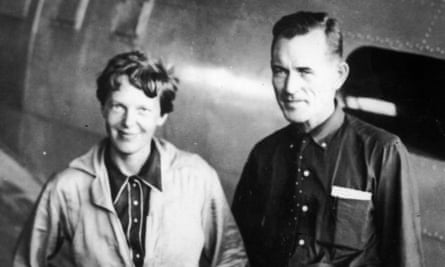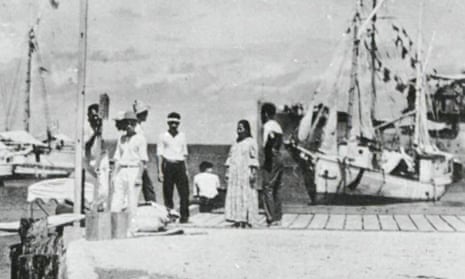Claims made in a US documentary that the pioneering aviator Amelia Earhart crash-landed on the Marshall Islands in the Pacific Ocean and was taken prisoner by the Japanese appear to have been proved false by a photograph unearthed in a travel book.
The History Channel documentary, Amelia Earhart: The Lost Evidence, which aired in the US on Sunday, made the claim that the American and her navigator, Fred Noonan, ended up in Japanese custody based on a photograph discovered in the US national archives that purported to show them standing at a harbour on one of the islands.
The film said the image “may hold the key to solving one of history’s all-time greatest mysteries” and suggested it disproved the widely accepted theory that Earhart and Noonan disappeared over the western Pacific on 2 July 1937 near the end of their attempt at a history-making flight around the world.
But serious doubts now surround the film’s premise after a Tokyo-based blogger unearthed the same photograph in the archives of the National Diet Library, Japan’s national library.
The image was part of a Japanese-language travelogue about the South Seas that was published almost two years before Earhart disappeared. Page 113 states the book was published in Japanese-held Palau on 10 October 1935.
The caption beneath the image makes no mention of the identities of the people in the photograph. It describes maritime activity at the harbour on Jabor in the Jaluit atoll – the headquarters for Japan’s administration of the Marshall Islands between the first world war and its defeat in the second world war.
The caption notes that monthly races between schooners belonging to local tribal leaders and other vessels turned the port into a “bustling spectacle”.
Kota Yamano, a military history blogger who unearthed the Japanese photograph, said it took him just 30 minutes to effectively debunk the documentary’s central claim.

“I have never believed the theory that Earhart was captured by the Japanese military, so I decided to find out for myself,” Yamano told the Guardian. “I was sure that the same photo must be on record in Japan.”
Yamano ran an online search using the keyword “Jaluit atoll” and a decade-long timeframe starting in 1930.
“The photo was the 10th item that came up,” he said. “I was really happy when I saw it. I find it strange that the documentary makers didn’t confirm the date of the photograph or the publication in which it originally appeared. That’s the first thing they should have done.”
Yamano’s Twitter post fuelled social media discussion of the possible cause of Earhart’s disappearance and criticism of the History Channel documentary.
The photograph shows a woman with her back to the camera, whom the film suggests is Earhart, alongside a man – purportedly Noonan – whose face is visible, with other people standing on a dock on Jaluit atoll in the Marshall Islands.
Earhart and Noonan were last seen taking off in her twin-engine Lockheed Electra on 2 July 1937, from Papua New Guinea en route to Howland Island, about 2,500 miles away.
The documentary, hosted by former FBI executive assistant director Shawn Henry, also alleges a cover-up, claiming that the US government knew of her whereabouts but did nothing to rescue her.
The film cites facial-recognition and other forensic testing that confirmed the photograph’s authenticity, and concluded that the two figures in question were likely to be Earhart and Noonan.
The film describes Earhart as “a world-famous aviator who got caught up in an international dispute, was abandoned by her own government, and made the ultimate sacrifice”.
Henry said: “She may very well be the first casualty of world war two.”
The picture “clearly indicates that Earhart was captured by the Japanese”, said retired US treasury agent Les Kinney, who unearthed the image in the US national archives in 2012.
The version of the photo Kinney found in the US archives is undated, but he has said he believes it was taken in July 1937 – a theory now disproved by the image from Japanese archives.
The Marshall Island theory, which the photograph is alleged to support, has been around since at least the 1960s and was fuelled by accounts from Marshall Islanders, who claimed they watched the aircraft land and saw Earhart and Noonan in Japanese custody.
The History Channel website said “new evidence” suggests that Earhart died in Japanese custody on the island of Saipan. Wally Earhart, Amelia’s cousin, has said – without offering evidence – that she died of dysentery and other illnesses, while Noonan was beheaded by the Japanese.
Conspiracy theories have abounded for decades, since no trace of Earhart, Noonan or their plane has ever been confirmed.
Other experts have cast doubt on the documentary’s photos claims. Ric Gillespie, executive director of the International Group for Historic Aircraft Recovery, said there was no evidence that the person in the photograph was Earhart.
Gillespie believes Earhart died as a castaway on the island of Nikumaroro, Kiribati, where a partial skeleton was discovered in 1940. “There is such an appetite for anything related to Amelia Earhart that even something this ridiculous will get everybody talking about it,” said Gillespie, author of Finding Amelia.
“This is just a picture of a wharf at Jaluit [in the Marshall Islands], with a bunch of people,” Gillespie said. “It’s just silly. And this is coming from a guy who has spent the last 28 years doing genuine research into the Earhart disappearance and led 11 expeditions into the South Pacific.”
Matthew B Holly, a military expert, told Agence France-Presse the photo appeared to have been taken about a decade earlier than the date given by the History Channel.
“From the Marshallese visual background, lack of Japanese flags flying on any vessels but one, and the age configuration of the steam-driven steel vessels, the photo is closer to the late 1920s or early 1930s, not anywhere near 1937,” he said.
